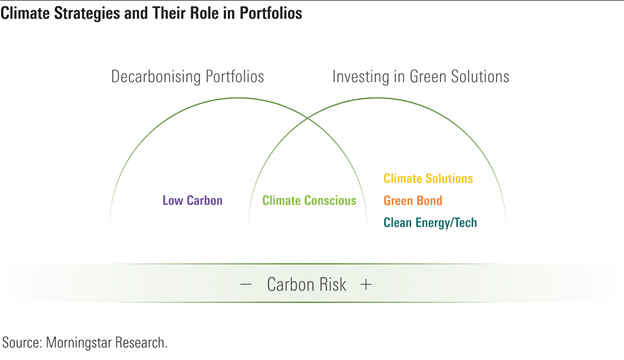
Find Climate Funds You Can Buy Right Now
Investors have a growing number of choices to seize climate-change-related opportunities, as well as to mitigate climate risk in their portfolios. Use this table to find funds available in your country.
How We Look at Climate Product Options
We divide climate products into five categories:
- Low Carbon funds seek to invest in companies with reduced carbon intensity and/or carbon footprint relative to a benchmark index. These funds are well diversified.
- Climate Conscious funds select or tilt toward companies that consider climate change in their business strategy and therefore are better prepared for the transition to a low-carbon economy. These funds are also well diversified.
- Climate Solutions funds only target companies that are contributing to the transition to a low-carbon economy through their products and services and that will benefit from this transition. These funds are less well-diversified and tilt toward industrials and technology.
- Clean Energy/Tech funds invest in companies that contribute to or facilitate the clean energy transition. These funds are concentrated in the industrials and technology sectors.
- Green Bond funds invest in debt instruments that finance projects facilitating the transition to a green economy.
This graphic indicates the different roles that these strategies play in portfolios.
Many Choices, But Relatively Few Have Long Track Records
The good news is that the investment industry has introduced a multitude of new funds globally to capture investor interest in investing in climate change, or, if you like, the energy transition.
Yet, many of these choices are unproven and much more volatile than diversified equity funds. As of the end of last year, US-domiciled climate tech funds had an average three-year standard deviation of 29.5 versus 18.4 for the Vanguard 500 fund, which tracks the S&P 500 benchmark. (Standard deviation is a measure of risk. The higher the number, the riskier the asset has been in the past.)
That’s where the Morningstar Rating for funds, known as the star rating, comes in. We've sorted the table above by this rating, which measures whether a fund has performed well on a risk-adjusted basis against its peers. For more background on its use and efficacy, read this column from Morningstar’s funds columnist John Rekenthaler.
This article contains material from Morningstar authors Jon Hale, Hortense Bioy, and Elizabeth Stuart











:quality(80)/cloudfront-us-east-1.images.arcpublishing.com/morningstar/6BCTH5O2DVGYHBA4UDPCFNXA7M.png)

















